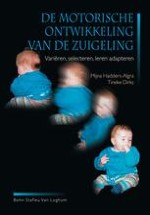Abstract
Lange tijd werd aangenomen dat de motorische ontwikkeling verliep volgens een autonoom proces van aflezen van genetisch bepaalde ontwikkelingsprogramma’s (Gesell, 1945; Illingworth, 1966). De aanhangers van de - later zo genoemde - Neurale Maturatie Theorieën dachten dat omgevingsfactoren het proces van ontwikkeling, het tot uitdrukking brengen van het motorische script, niet of nauwelijks konden beïnvloeden. Het denken in termen van strakke, genetisch bepaalde schemata, leidde tot de opstelling van algemeen geldende regels voor de ontwikkeling van motoriek. Voorbeelden daarvan zijn de regel van het cranio-caudale en die van het proximo-distale verloop van de postnatale ontwikkeling. In deze context schreven Gesell en Amatruda (1947) hun ‘Developmental Diagnosis’. In dit innovatieve werk beschreven zij hoe de motorische ontwikkeling gemeten kan worden door middel van het bepalen van de motorische mijlpalen. Een andere belangrijke gedachtegang in de Neurale Maturatie Theorieën was de idee dat de motorische ontwikkeling totstandkomt doordat de invloed van de cerebrale cortex op de zogenaamde lagere reflexen steeds groter wordt: ‘Bij de pasgeborene functioneren de diverse onderdelen van de hersenen niet even goed; liever gezegd, functionele hersenactiviteit ontstaat eerst in de hersenstam om zich vervolgens uit te breiden naar de cerebrale hemisferen. De cerebrale hemisferen zijn bij de pasgeborene niet actief. Door het ontbreken van remmende invloeden vanuit de cerebrale hemisferen op dieper gelegen hersencentra worden de reflexen van de hersenstam niet onderdrukt, waardoor deze reflexen tot uitdrukking kunnen komen’ (Peiper, 1963, p.1491).

